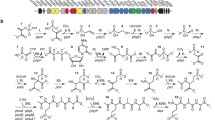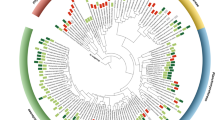Abstract
The evolution of aromatic amino acid biosynthesis and its regulation is under study in a large assemblage of prokaryotes (Superfamily A) whose phylogenetic arrangement has been constructed on the criterion of oligonucleotide cataloging. One section of this Superfamily consists of a well defined (rRNA homology) cluster denoted as Group III pseudomonads. Pseudomonas acidovorans ATCC 11299a, a Group III member, was chosen for indepth studies of 3-deoxy-d-arabino-heptulosonate 7-phosphate (DAHP) synthase, the initial regulatory enzyme of aromatic biosynthesis. This strain is of particular interest for evolutionary studies of aromatic metabolism because it possesses phenylalanine hydroxylase, an enzyme whose physiological role and distribution among prokaryotes is largely unknown. Although P. acidovorans ATCC 11299a has been of uncertain identity, we now establish it unambiguously as a species of acidovorans by virtue of its 87% DNA homology with P. acidovorans ATCC 15668 (type strain). This result conformed with enzyme patterning studies which placed ATCC 11299a into pseudomonad Group IIIa, a subgroup containing the acidovorans species. Crude extracts of Group III pseudomonads had previously been shown to share, as a common group characteristic, sensitivity of DAHP synthase to feedback inhibition by either l-tyrosine or l-phenylalanine. Detailed studies with partially purified preparations from strain ATCC 11299a revealed the presence of two distinct regulatory isozymes, DAHP synthase-phe and DAHP synthase-tyr. DAHP synthase-tyr is tightly controlled by l-tyrosine with 50% inhibition of activity being achieved at 4.0 μM effector. DAHP synthase-phe is inhibited 50% by 40 μM l-phenylalanine and exhibits dramatic changes in levels of activity, as well as chromatographic elution patterns, in response to dithiothreitol. This two-isozyme pattern of DAHP synthase has not been described previously, although it may prove to be widespread.
Similar content being viewed by others
Abbreviations
- DAHP:
-
3-deoxy-d-arabino-heptulosonate 7-phosphate
- E4P:
-
d-erythrose-4-phosphate
- PEP:
-
phosphoenolpyruvate
- DTT:
-
dithiothreitol
- BSA:
-
fraction V bovine serum albumin
References
Baumann L, Baumann P (1978) Studies of relationship among terrestrial Pseudomonas, Alcaligenes and enterobacteria by an immunological comparison of glutamine synthetase. Arch Microbiol 119:25–30
Bradford MM (1976) A rapid and sensitive method for the quantitation of microgram quantities of protein utilizing the principle of protein-dye binding. Anal Biochem 72:248–254
Buchanan BB (1980) Role of light in the regulation of chloroplast enzymes. Ann Rev Plant Physiol 31:341–374
Byng GS, Whitaker RJ, Gherna RL, Jensen RA (1980) Variable enzymoloical patterning in tyrosine biosynthesis as a means of determining natural relatedness among the Pseudomonadaceae. J Bacteriol 144:247–257
Byng GS, Kane JF, Jensen RA (1982) Diversity in the routing and regulation of complex biochemical pathways as indicators of microbial relatedness. Crit Rev Microbiol 9:227–252
Byng GS, Berry A, Jensen RA (1983a) A pair of regulatory isozymes for 3-deoxy-d-arabino-heptulosonate 7-phosphate synthase is conserved within group I pseudomonads. J Bacteriol 156:429–433
Byng GS, Johnson JL, Whitaker RJ, Gherna RL, Jensen RA (1983b) The evolutionary pattern of aromatic amino acid biosynthesis and the emerging phylogeny of pseudomonad bacteria. J Mol Evol 19:272–282
Byng GS, Whitaker RJ, Jensen RA (1983c) Evolution of l-phenylalanine biosynthesis in rRNA homology group I of Pseudomonas. Arch Microbiol 136:163–168
Cerutti P, Guroff G (1965) Enzymatic formation of phenylpyruvic acid in Pseudomonas sp. (ATCC 11299a) and its regulation. J Biol Chem 240:3034–3038
Cohen GN, Stanier RY, LeBras G (1969) Regulation of the biosynthesis of amino acids of the aspartate family in coliform bacteria and pseudomonads. J Bacteriol 99:791–801
Davies WD, Davidson BE (1982) The nucleotide sequence of aroG, the gene for 3-deoxy-d-arabino-heptulosonate 7-phosphate synthetase (phe) in Escherichia coli K-12. Nuc Acids Res 10:4045–4058
DeCicco BT, Umbreit WW (1964) Utilization of aromatic amino acids by Hydrogenomonas facilis. J Bacteriol 88:1590–1594
Fox GE, Stackebrandt E, Hespell RB, Gibson J, Maniloff J, Dyer TA, Wolfe RS, Balch WE, Tanner RS, Magrum LJ, Zablen LB, Blakemore R, Gupta R, Bonen L, Lewis BJ, Stahl DA, Luehrsen KR, Chen KN, Woese CR (1980) The phylogeny of prokaryotes. Science 209:457–463
Friedrich B, Schlegel HG (1972) Die Hydroxylierung von Phenylalanin durch Hydrogenomonas eutropha H16. Arch Mikrobiol 83:17–31
Guroff G, Ito T (1963) Induced soluble phenylalanine hydroxylase from Pseudomonas sp. grown on phenylalanine or tyrosine. Biochim Biophys Acta 77:159–161
Guroff G, Karadbil M, Dayman J (1970) The effect of bovine serum albumin on the measurement of the activity of highly purified Comamonas phenylalanine hydroxylase. Arch Biochem Biophys 141:342–345
Jensen RA (1976) Enzyme recruitment in evolution of new function. Annu Rev Microbiol 30:409–425
Jensen RA (1985) Biochemical pathways in prokaryotes can be traced backwards through evolutionary time. Mol Biol and Evol 2
Jensen RA, Hall GC (1982) Endo-oriented control of pyramidally arranged metabolic branchpoints. Trends Biochem Sciences 7: 177–180
Jensen RA, Nester EW (1966) Regulatory enzymes of aromatic amino acid biosynthesis in Bacillus subtilis. I. Purification and properties of 3-deoxy-d-arabino-heptulosonate 7-phosphate synthetase. J Biol Chem 241:3365–3372
Jensen RA, Rebello JL (1970) Comparative allostery of microbial enzymes at metabolic branch points: evolutionary implications. Dev Ind Microbiol 11:105–121
Jensen RA, Nasser DS, Nester EW (1967) Comparative control of a branchpoint enzyme in microorganisms. J Bacteriol 94:1582–1593
Johnson JL (1981) Genetic characterization. In: Gerhardt P (ed) Manual of methods for general bacteriology. American Society for Microbiology, Washington DC, pp 450–472
Letendre CH, Dickens G, Guroff G (1974) The tryptophan hydroxylase of Chromobacterium violaceum. J Biol Chem 249:7186–7191
Marmur J (1961) A procedure for the isolation of deoxyribonucleic acid from microorganisms. J Mol Biol 3:208–218
Palleroni NJ, Kunisawa R, Contopoulou R, Doudoroff M (1973) Nucleic acid homologies in the genus Pseudomonas. Int J Syst Bacteriol 23:333–339
Queener SF, Gunsalus IC (1970) Anthranilate synthetase enzyme system and complementation in Pseudomonas species. Proc Natl Acad Sci USA 67:1225–1232
Ralston E, Palleroni NJ, Doudoroff M (1972) Deoxyribonucleic acid homologies of some so-called “Hydrogenomonas” species. J Bacteriol 109:465–466
Rosenfeld H, Feigelson P (1969) Synergistic and product induction of the enzymes of tryptophan metabolism in Pseudomonas acidovorans. J Bacteriol 97:697–704
Selin YM, Harich B, Johnson JL (1983) Preparation of labelled nucleic acid (nick translation and iodination) for DNA homology and rRNA hybridization experiments. Curr Microbiol 8:127–132
Stackebrandt E, Woese CR (1981) The evolution of prokaryotes. In: Carlile MJ, Collins JF, Moseley BEB (eds) Molecular and cellular aspects of microbial evolution, 32nd Symp Soc Gen Microbiol. Cambridge Univ Press, Cambridge, pp 1–32
Stanier RY, Hayaishi O, Tsuchida M (1951) The bacterial oxidation of tryptophan. I. A general survey of the pathways. J Bacteriol 62:355–366
Stanier RY, Palleroni NJ, Doudoroff M (1966) The aerobic pseudomonads: a taxonomic study. J Gen Microbiol 43:159–271
Wheelis ML, Palleroni NJ, Stanier RY (1967) The metabolism of aromatic acids by Pseudomonas testosteroni and P. acidovorans. Arch Mikrobiol 59:302–314
Whitaker RJ, Byng GS, Gherna RL, Jensen RA (1981a) Comparative allostery of 3-deoxy-d-arabino-heptulosonate 7-phosphate synthetase as an indicator of taxonomic relatedness in pseudomonad genera. J Bacteriol 145:752–759
Whitaker RJ, Byng GS, Gherna RL, Jensen RA (1981b) Diverse enzymological patterns of phenylalanine biosynthesis in pseudomonads are conserved in parallel with deoxyribonucleic acid homology groupings. J Bacteriol 147:526–534
Whitaker RJ, Fiske MJ, Jensen RA (1982) Pseudomonas aeruginosa possesses two novel regulatory isozymes of 3-deoxy-d-arabino-heptulosonate 7-phosphate synthase. J Biol Chem 257:12789–12794
Yamada Y, Takinami-Nakamura H, Tahara Y, Oyaizu H, Komagata K (1982) The ubiquinone system in the strains of Pseudomonas species. J Gen Appl Microbiol 28:7–12
Author information
Authors and Affiliations
Rights and permissions
About this article
Cite this article
Berry, A., Johnson, J.L. & Jensen, R.A. Phenylalanine hydroxylase and isozymes of 3-deoxy-D-arabino-heptulosonate 7-phosphate synthase in relationship to the phylogenetic position of Pseudomonas acidovorans (Ps. sp. ATCC 11299a). Arch. Microbiol. 141, 32–39 (1985). https://doi.org/10.1007/BF00446736
Received:
Accepted:
Issue Date:
DOI: https://doi.org/10.1007/BF00446736




